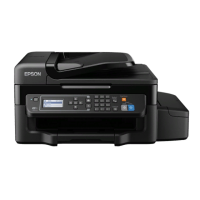2016/09/02
Revision: 1 Page: 77
CHAPTER 8: Device ID
These printers can send its device ID when it is requested.
When IEEE1284.4 can be enabled, (When IEEE1284.4 mode in turning power on is ON or AUTO)
@EJL<SP>ID<CR><LF>
MFG:EPSON;
CMD:ESCPL2,BDC,D4,D4PX,ESCPR1,END4; (*1)
MDL:Model Name;
CLS:PRINTER;
DES:EPSON<SP>Model Name;
CID:EpsonRGB;
FID:FXA,DPN,WFA,ETA,AFA,DAN,WRA; (*2)
RID:<nn>; (*3)
DDS:<size>; (*4)
ELG:<groupnum>; (*5)
When IEEE1284.4 cannot be enabled, (When IEEE1284.4 mode in turning power on is OFF)
@EJL<SP>ID<CR><LF>
MFG:EPSON;
CMD:ESCPL2,BDC,ESCPR1,END4; (*1)
MDL:Model Name;
CLS:PRINTER;
DES:EPSON<SP>Model Name;
CID:EpsonRGB;
FID:FXA,DPN,WFA,ETA,AFA,DAN,WRA; (*2)
RID:<nn>; (*3)
DDS:<size>; (*4)
ELG:<groupnum>; (*5)
*1: ‘END4’ means supporting ‘The extension for non-D4’.
*2: FID parameter <mm> is as follows.
FX:FAX, DP:DuplexPrint, WF:WiFi, ET:Ether, AF:ADF, DA:ADF(Duplex), WR:WebRemoteOperation
xxA:Available, xxN:Not available, xxD;Don’t Care (This function is divide by the element other than FID.)
*3: RID parameter:
<nn> is two bytes ASCII code that indicates product region ID in hexadecimal.
For example, if the region ID is F1h, RID description is "RID:F1;".
*4: DDS parameter:
<size> is six bytes ASCII code that indicates minimum dummy data size for END4 protocol in hexadecimal.
For example, if the size is 20000h, DDS description is "DDS:020000;".
*5: ELG parameter:
<groupnum> is four bytes ASCII code that indicates a number for Error List Group in hexadecimal.
For example, if the group number is 000Fh, ELG description is "ELG:000F;".
Device ID Model Name list
Model Name
ET-4500
L575

